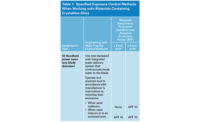The respirable crystalline silica (RCS) rule applies to all occupational exposures of RCS in construction work, except where employee exposure will remain below the action level of 25 micrograms per cubic meter of air (25 μg/m3) as an 8-hour time-weighted average (TWA) under any foreseeable conditions. OSHA’s current permissible exposure limit (PEL) for RCS is 50 μg/m3, per 1926.1153. Prior to 2016, OSHA’s construction industry PEL for crystalline silica was 250 μg/m3. It was established in 1971 based on research from the 1960s. Recent scientific evidence, however, shows this PEL didn’t adequately protect worker health.
Crystalline silica is one of the most common elements on the planet, just behind oxygen. About 2.3 million workers are exposed to it in their workplace. It’s about 100 times smaller than sand and can be found on construction sites in building materials such as concrete, block, stone, sand, and mortar. Workers are commonly exposed to RCS when they cut, sand, drill, grind, or crush materials containing it. Workers exposed to RCS have an increased risk of developing serious adverse health effects including silicosis, lung cancer, chronic obstructive pulmonary disease, and kidney disease.
Every employer should include the following
elements in their RCS workplace safety plan:
- Exposure control methods;
- Written exposure control plan;
- Medical surveillance; and
- Employee information, training, and recordkeeping.
Exposure control methods
Employers are required to use exposure control methods to keep worker exposures at or below the PEL. Two types of exposure controls discussed in 1926.1153 are:
- Specified controls, and
- Alternative controls.
Under specified controls, the employer must implement engineering controls, work practice controls, and respiratory protection to reduce exposure below the PEL. Table 1 in the standard helps employers to implement specified controls correctly for common construction tasks. By following this table, OSHA doesn’t require employers to further assess employee exposures or separately ensure compliance with its PEL.
If workers aren’t performing any of the common construction tasks from Table 1, or if it can’t properly be followed, the employer must implement alternative controls. Under alternative control methods, the employer is required to use engineering and work practice controls. This includes assessing employee exposures and performing air sampling to ensure that exposures are at or below the PEL. The standard lists two air-sampling methods the employer can choose from: performance or scheduled sampling methods. If worker exposure is above the PEL after using engineering and work practice controls, the employer will need to supplement these controls with respiratory protection.
Written exposure control plan
Imagine taking a cross-country trip by getting in your car without any planning and driving into the sunset with no map, guide, or GPS. You probably won’t end up where you intended to go. Planning is critical to our everyday life, including workplace safety. Having an effective exposure control plan and following it is needed to protect workers from exposure. Make sure your plan includes these four elements:
- A description of the work tasks that have exposure to silica;
- Engineering controls, work practice controls, and respiratory protection that will be used;
- Housekeeping measures that will be taken; and
- Details about how access to regulated work areas will be restricted.
Each of the elements, except housekeeping, are discussed throughout this article. Employers aren’t allowed to dry sweep or dry brush regulated work areas. Doing so can increase exposure. Section 1910.1153 requires employers to use wet sweeping, HEPA-filtered vacuuming, or other related means that wouldn’t increase worker’s risk to exposure. Generally, OSHA doesn’t allow workers to use compressed air to clean their clothes or surfaces unless one of these two exceptions apply:
- A ventilation system is used that effectively captures any dust cloud created by using the compressed air; or
- No alternative method is feasible.
Remember to have a competent person update your plan as needed and to evaluate its effectiveness at least annually.
Medical surveillance
When engineering and workplace place controls aren’t effective in controlling exposure, employers are required to supplement these controls with respiratory protection. When respiratory protection is used for more than 30 days a year, employers must make medical surveillance available to workers. It must be available at no cost, at a reasonable time and place, and performed by a physician or other licensed healthcare professional.
Workers must be offered a medical exam within 30 days of initial assignment, unless they’ve received one that meets the standard’s requirements within the past three years. Thereafter, the employee must receive a follow-up exam every three years, or more often if recommended by the physician.
Under 1926.1153, medical examinations must include a medical and work history review, a physician examination, chest x-ray, a pulmonary function test, an initial exam for latent tuberculosis infection, and any other test recommended by the physician.
Employee information, training & recordkeeping
Employers must provide information and training to workers about how to protect themselves from silica exposure. Information and training must include at least these things:
- Health hazards associated with silica exposure;
- Specific measures the employer has taken to protect workers from silica exposure;
- The contents of the 1926.1153 Respirable Crystalline Silica standard;
- Access to competent person designated by the employer; and
- Information about the purpose and description of the medical surveillance program.
The standard also requires employers to maintain records of certain information. Records must be maintained for 30 years and made available to employees according to 1910.1020. Include all of these things in your silica workplace safety plan and rest assure that your workers will be safe from RCS exposure.



